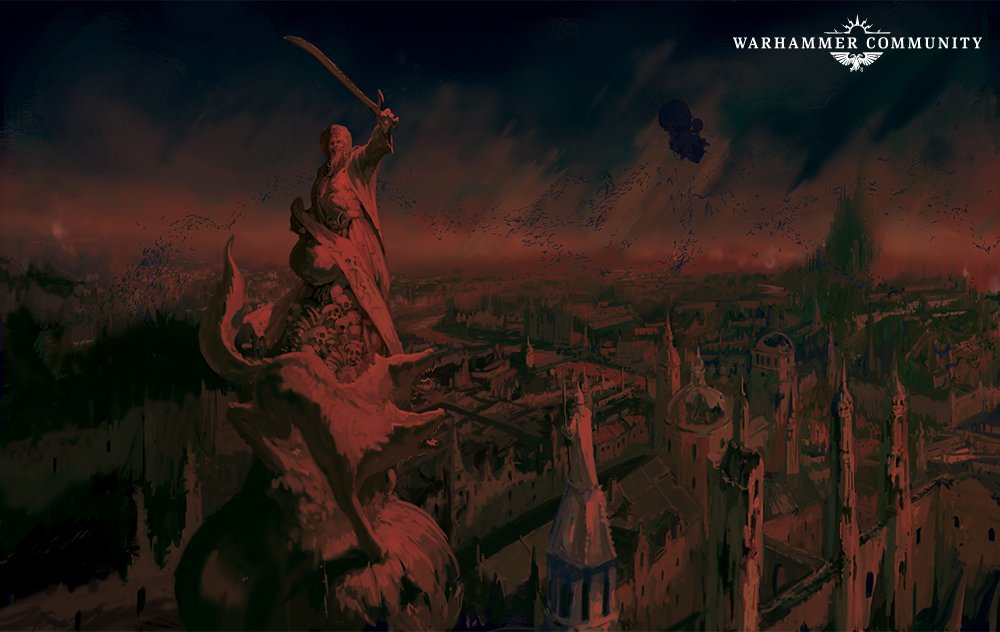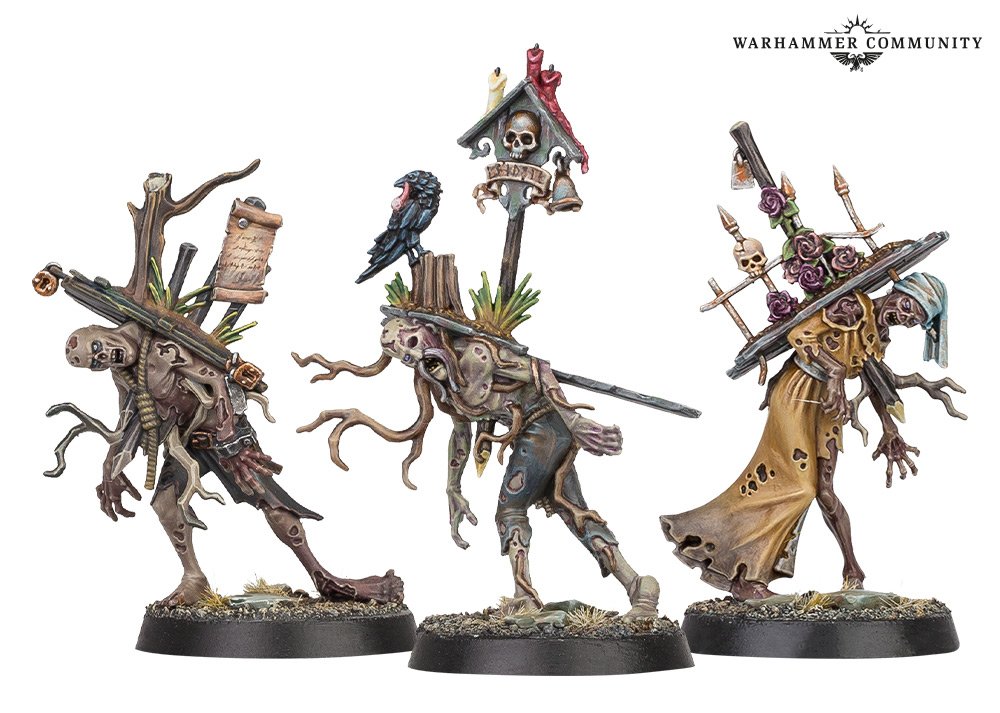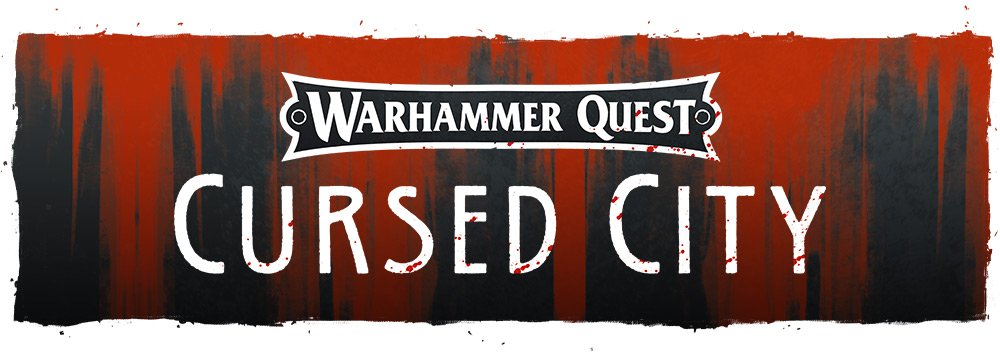One of the most hotly anticipated Games Workshop products of the year so far is finally here! Warhammer Quest: Cursed City brings 1 to 4 players through the streets of Ulfenkarm to dispatch the undead denizens within. With luck, skill and bravery these vampires hunters may be able to defeat the many lieutenants around the city and find the source of Immortality to it’s vampire ruler, Radukar the Wolf, and destroy him for good.
Note: This article was originally published on April 3, 2021

The Contents Within
RagnarokAngel: This box is incredible With how much they managed to jam in here. First, of course, the models. The models are once again top-notch, they’re all Easy to Build snap fit models but Games Workshop has come a long way with these. While they used to not always secure well and would require glue anyway, the engineering behind these is really well executed and they fit like a dream. The zombies and skeletons are built with similar templates but have enough variation to swap around that they don’t have the Nighthaunt Chainrasp problem where 40 models look essentially identical. Overall, very impressed by the build quality and how gorgeous the models are. No complaints here.
The number of tokens and map tiles is frankly staggering and while the box contains a ton of baggies to organize them a wish they could have added some trays or something because between everything included, especially the models with thin and easily broken pieces, fitting them all in is pretty precarious. You’ll probably want a separate case for the models, if you can.
Raf: Blackstone Fortress had this same problem. Plenty of room for the baggies, books, and tokens, but storing the minis was a problem. I ended up with a Plano storage box that held all the minis and fit in the box. This is definitely and odd spot for these GW board games/minis games; the board game industry has broadly embraced larger boxes with molded inserts but that creates significant production issues for GW.
Storage aside, everything else is a premium product. They wisely moved away from the 5 rulebook model they attempted with Blackstone. Cursed City has a main rulebook that tells you how to play (in both tutorial and reference form) and a large quest book. The latter has the specifics for the Ulfenkarn in Peril Campaign, including backstory on Journey setup and the Crisis events.
Playing the Game
Raf: Broadly speaking, Cursed City functions very similarly to BSF. It is clearly an iteration that manages to streamline various elements and builds off the 40K version. You could almost grab this box and start playing with the BSF rules; I’d never recommend that but that’s how similar they are.
Rather than exploring an alien fortress, the heroes of Cursed City are trying to liberate an embattled populace from the undead rule of Radukar. A new addition to the system is a card that tracks the level of influence and fear the populace has of Radukar. Success in your journeys, and various story beats, can cause these counters to go up and down and will influence play.
Another big change is setup. Blackstone followed a familiar beat: shuffle up an encounter deck of 8 cards and play your way through. Some were narrative cards, and others had you set up a table full of hex tiles and fight your way through baddies. In Cursed City the leader will choose a Journey type. The most basic is the Hunt that has you crawl across the map fighting baddies and picking up treasure. It gets a bit more exciting pretty quickly.
Scavenge journeys ramp up the difficulty but give you the opportunity to grab extra resources. Most exciting is the Deliverance mission type. This simulates a mad dash through the city trying to escape an encroaching curse. The board starts small: two tiles. But you’ve got to quickly get from one end to the other and add another tile, randomly drawn from the deck. You keep doing this until you are out of cards, building the map in a chaotic mad dash. The city itself fights you here. Strict rules for board placement mean it’s possible to hit a dead end. If you’re unable to place the exit tile you are hit by the curse.
Cursed City follows in the tradition of dungeon crawlers with looting and equipment. Realmstone makes an appearance and can be cashed in to buy enhancements to your weapons and armor. Each hero is limited to one enhancement in each category. I’m initially excited about this; BSF equipment cards tended to sprawl and layer unnecessary complexity. My hope is that this simple system can reduce overhead while keeping the opportunity for exciting plays.
RagnarokAngel: For those unfamiliar with the basics of the Warhammer Quest system, scenarios are generated by drawing cards, which list off different layouts and enemy combinations. Players each choose a Hero with unique talents and abilities. There must always 4 Heroes, if there are less than 4 players than some players will double up, allowing you to play solo if you wish (enemies are controlled by dice rolls that determine their actions).
Heroes have 4 “activation dice” on their character cards which are rolled each turn, and then placed on their card to represent the numbers rolled. During your turn, the dice can be spent on actions such as moving, attacking, opening chests etc, with each action having a minimum dice value. Getting wounded hurts not only your health but reduces the number of actions you get per turn, making you more vulnerable. Complete the objective and you walk off with loot to take on your next adventure.
This game doesn’t shake up the core formula very much, it still uses the same sorts of d4s, d6s, d8s and d10s it always did but a lot of the elements surrounding it have improved. One of the core issues with Blackstone Fortress is how easy it was to sit near the exit and gun down all the enemies as they spawned.The more melee centric Heroes and change in objectives make movement much more key to success and I’ll need to play more games to be sure but it seems like an improvement.

The Campaign
RagnarokAngel: The Campaign built in is entitled Ulfenkarn in Peril and details the Heroes included fighting the Vampire overlord of the city of Ulfenkarn, Radukar the Wolf. Ulfenkarn is a human city within Shyish, long ago when it was known as Mournheld, it was held siege by a Khornate Daemon Prince, and at the last moment they were saved by Radukar, a Vampire Lord. In exchange, Radukar asked to join the high council of the city. They knew it was a trap, but their defenses shattered by Khornate invasions, they had little choice.
Nagash’s Necroquake amplified the powers of the undead tenfold, and cast an eternal night over the city, allowing the Vampire overlords free reign over the city. Radukar has obtained a rare artifact that makes it so if he is slain, instead of his soul being taken, his murderer’s will be instead, granting him effective immortality. The City has fallen into chaos, with pockets of mortals attempting to carve out a meager existence, hiding from the undead. A small pocket of Heroes have broken from the city gaol and have their sights on defeating Radukar’s generals, and if they can find the secret to Radukar’s immortality, to destroy him for good.
The campaign is broken up into 6 “Decapitation” missions which are story missions defeating each lieutenant, and finally Radukar. The appointed Leader can decide where to tackle one of these missions, or another mission to help the party grow stronger first, leveling up and obtaining new artefacts. If the Heroes can get to Radukar and destroy him, a sealed envelope is included that describes what happens next (I assure you, I have not opened it ).
Raf: The big addition to the campaign system is the Crisis system and I can’t wait to get into this. Story triggers will see a hero leave the board to deal with an emerging crisis. These are presented as Choose Your Own Adventure style narrative style paragraphs. The heroes controller will read a blurb and then make a choice that directs them to a specific entry.
The consequences for these can be positive or negative. Maybe you get an influence point for helping a downtrodden civilian or maybe you’re responsible for fomenting more fear. This hero’s comrades are left to deal with what’s on the board until they return. Good luck.
Using the models in Warhammer: Age of Sigmar
RagnarokAngel: I’m taking a bit of a detour here to discuss the Warscrolls included to play these models in Warhammer:Age of Sigmar as that was a primary perk to me and many others. It gets a little ranty, but it’s here not only to be thorough but also as a warning.
The Undead Hordes
RagnarokAngel: I’m going to get this out of the way now. When the game was initially announced, a few photos had leaked online hinting at a new faction, the Soulblight Gravelords. This has caught the community by storm, because hey, Vampires are really cool. When Cursed City was announced, many had a similar thought: This will be like a starter box for soulblight! Tons of skeletons, zombies, vampires and necromancers inside why that’s gotta be close to 1000 pts right?
If you are buying this box with the sole intent of starting Soublight Gravelords do not do this. At least how this is written, this is a terrible way to get into the faction, unless something drastically different occurs in the final Battletome.
The zombies and skeletons contained with the box are meant to replace the woefully out of date Zombie and Skeleton Warriors models, and they look great! However, the builds don’t actually let you do anything viable for playing them in Age of Sigmar. The warscrolls are identical to the ones currently in Battletome: Legions of Nagash but there are no banners for the zombies or instruments for either squad (Despite still appearing on the warscroll. Also, the Skeleton Warriors have a mish-mash of swords and spears, which you can’t do. Most likely these are easy-to-build models coming ahead of the real deal with the Soulblight Battletome and only having 10 isn’t the strong start it sounds.
It gets worse with the rest of the undead roster as well. Everyone except the zombies and skeleton warriors are treated similar to an Underworlds Warband. They need to be taken together as a group, and cost a whopping 680 points. Without seeing the soulblight gravelords tome it’s hard to tell exactly how these will integrate into it either. Rules as written you can’t use these guys in anything but Grand Alliance: Death, the old ass nature of the Legions of Nagash tome mean you can’t use anything that isn’t explicitly included in the book or its errata, and these aren’t.
There isn’t any special SOULBLIGHT GRAVELORDS keyword, which will probably happen when that book hits. Unless these warscrolls get Errata’d, these will likely have to go in the dustbin. Real shame, because they’re great models with some really cool rules. You can probably see them over on the Games Workshop website by the time this website goes live, if you want to look for yourself.
The Heroes
RagnarokAngel: The Heroes get off better than the undead, but not by much. Everyone except for Qulathis (The Aelven Archer) and Dagnai Holdenstock (The Duardin) are part of the Cities of Sigmar. Qualthis is part of the Sylvaneth and Dagnai is part of Kharadron Overlords.
Thankfully you don’t take them as a squad but another problem comes up: Each character has a subfaction, like the CoS heroes being part of the city of Ulfenkarn. As per the rules any unit that has a subfaction can be included in another list, but doesn’t gain the subfaction’s benefits. Sadly, Ulfenkarn doesn’t have any rules, and unlike 40k you’re not allowed to substitute the rules of one city for another. So while you can include them, they will not get the subfaction rules, which can be worked around. They can also be backdoored into a Stormcast Eternals army, using the Stormkeep rules from Morathi.
The characters are surprisingly unique, not fitting easily into established archetypes. Cleona Zeitengale is a Human Priest, which is unique for the faction. Emelda and Brutogg are melee focused Heroes, and Jelsen and Glaurio are ranged heroes and Octren is a different take on the Wizard from the Battlemage. The fact they probably won’t be usable in most cases is a real missed opportunity.
Final Thoughts on the Warscrolls
RagnarokAngel: It’s a real shame what happened here. The Warscrolls are surprisingly unique, often when writing warscrolls for other games (i.e. Warhammer: Underworlds) the efforts are pretty tame. Usually there’s an analog to a generic Hero, with a slight improvement, and the rest of the warband is some mish mash of models from different units. Not so here, many of these are unique archetypes with no clear analogues to generic equivalents. Many of these characters actually fill unique niches and the Heroes could be viable in some Cities of Sigmar lists.
The fate of the game really holds it back. It’s not entirely clear if this game is a one print run or if expansions will come. If so it means these characters could forever be locked away, which would be a damned shame. I’d love to see rules for Ulfenkarn in Cities of Sigmar as well, but it’s unlikely that will ever happen. I know I spent a long time beating a dead horse here but I just want readers to be sufficiently warned that these are not the way into a new army.

Final Thoughts
Raf: Blackstone Fortress was a fantastic Quest adventure. The dice activation system felt fresh not just to a GW game but to tabletop dungeon crawling in general. It’s clear the design team is learning from the larger board game hobby and applying modern design to their games and that is continuing.
Slight tweaks to combat and initiative will make play smoother, and moving to squares over hexes should make building your board much faster. I’m also a fan of the Day/Night cycle. The system and world is getting richer.
More than anything, I think the Crisis system is a fantastic addition. The worlds of GW are so rich but it often feels like they are being revealed to you. This system gives you a small bit of narrative agency and I hope it’s built upon in future expansions.
RagnarokAngel: I confess I wish I had more time to play this before reviewing, as I did not have an opportunity to run a 4 player game until after this review goes out. A single player mode is equivalent, since you always need 4 characters, but its very micro-heavy and the joy is of course hanging with friends.
Mechanically, I love what I see. It’s the Warhammer Quest design through and through and compromises were not made here. There’s tons of models, great fluff, and the way the cards and rulebook is packaged beg to be explored. The setting is very cool and I think it feels like something out of Warhammer Fantasy, with little touches of Age of Sigmar in there.
It’s a damn shame what happened with the Age of Sigmar warscrolls and I think it’ll let a lot of people down, but the game itself is very solid if that’s what you’re here for. I can’t wait to see what is at the end of the journey.
If you have any questions or comments, shoot us an email at contact@goonhammer.com or leave a comment below!


